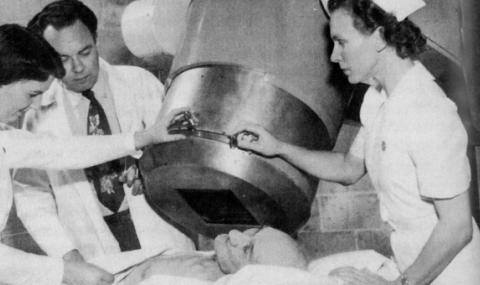| Right Ventricle
Waveform - Direct Measurement
Note that the rise in the right ventricular pressure occurs simultaneous with the QRS (the pressure rise is produced by ventricular depolarization and begins before mechanical systole). The small rise in ventricular pressure that occurs as a result of atrial contraction is identified by the arrow. |
|
| Right Ventricle
Waveform from the tip of a Pulmonary Artery Catheter
The detection of the rise in the right ventricular pressure wave is delayed because of the transit time through the catheter (110 cm in length), and appears later than in the direct measurement (highlighted by the orange line). The small rise in ventricular pressure that occurs as a result of atrial contraction is identified by the blue arrow. Note the large difference between the systolic and diastolic pressures, making the right ventricular waveform "taller". The right ventricle and pulmonary artery systolic presures are the same, but the right ventricular diastolic pressure is much lower than that of the pulmonary artery below (the right ventricular diastolic pressue will be similar to the right atrial diastolic pressure). |
|
|
Pulmonary Artery Waveform from the tip of the Pulmonary Artery Catheter When compared to the right ventricular waveform, the rise in the pulmonary artery tracing occurs later in relationship to the QRS (highlighted by the red line). The rise in the pulmonary artery pressure occurs after mechanical systole propels blood into the pulmonary circuit. Compare the distance from the start of the QRS to the rise in the pressure waveform between the RV tracing above, and this PA tracing (highlighted by green lines). Note that the systolic pulmonary artery pressure is very similar to the right ventricular systolic pressue. The diastolic pulmonary artery pressure is higher. The dicrotic notch (blue arrow) represents the closure of the pulmonic valve and the beginning of diastole. |






